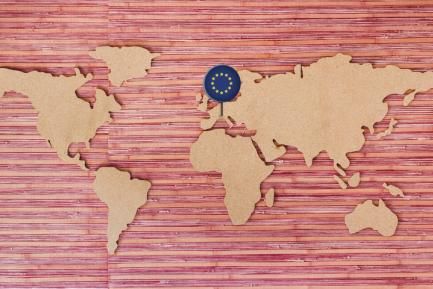Geopolitical uncertainty and economics: Deep impact?
One recurring theme in the media is the relationship between geopolitics and economic variables. But not only in the media: economists are also increasingly aware of the importance of geopolitical risks in accurately gauging economic prospects. But although geopolitics may be in vogue, their relationship has hardly been quantified. This article provides a preliminary examination of the issue.
To accurately measure global geopolitical uncertainty we have created an index that takes into account both political uncertainty at a global level and the trend in conflicts, also at a global level.1 To begin our analysis, it is useful to look at the degree of correlation between our geopolitical uncertainty index and various indexes for economic activity. First of all, we have analysed the relationship between this index and the global PMI business sentiment index. As can be seen in the first chart, the relationship between them is clearly negative: the higher the geopolitical uncertainty index, the lower the business sentiment index. Another indication of the close relationship between both indexes is that an increase in the uncertainty index of a magnitude equivalent of that to November 2016, after Donald Trump’s unexpected victory, goes hand in hand with a 4-point reduction in the PMI index. To provide a clear idea of this magnitude, the central 50% of observations of the PMi index are located within a range of 5 points.
Another way of analysing the relationship between geopolitical uncertainty and economic activity is to directly observe the correlation between geopolitical uncertainty and world GDP growth. In this case, an increase in uncertainty equivalent to that of Q4 2016 tends to be associated with a decrease in world GDP growth of 0.3 pp in the same quarter.
Finally, another way of quantifying t the relationship between the geopolitical risk index and economic activity indicators is to compare it with the correlation observed with indicators that are similar but from other areas. One good benchmark is the financial volatility index, the VIX, as it is commonly agreed that increases in the VIX tend to have a considerable effect on economic activity. An increase of the same magnitude in either index tends to be associated with a similar decrease in world GDP growth. Specifically, if we apply a shock to the VIX index equivalent to the one occurring in the geopolitical risk index in Q4 2016, the reduction in world GDP growth would be approximately 0.4 pp.2
Such findings are useful for a preliminary analysis of the relationship between geopolitics and the economy but they only measure correlations. In other words, they show how economic and geopolitical variables move in synch but do not indicate the cause of this effect
(Does geopolitical uncertainty increase purely due to geopolitical reasons or are such changes caused by other variables? ). To carry out a more sophisticated analysis, we have used a statistical technique3 that quantifies the impact of an exogenous uncertainty shock caused by geopolitical reasons, on the economy over time. As can be seen in the second chart, it is estimated that a shock of uncertainty, of a magnitude such as that occurring in Q4 2016, significantly reduces world growth by almost 1 pp between six months and one year after it occurs.
To properly understand how global geopolitical uncertainty operates, one important question is whether its impact is similar in both advanced and emerging countries. As can be seen in the third chart, on the whole emerging countries withstand geopolitical uncertainty much worse than advanced economies. Specifically, at the peak of the geopolitical shock (three quarters after it occurred), the reduction in GDP growth in the emerging economies is 1.45 greater than in the advanced. The effect on emerging countries also lasts longer than in the advanced. This asymmetry observed between the advanced and emerging blocs might be due to the fact that advanced countries have a more mature and well-established institutional system which provides them with a larger buffer to tackle geopolitical uncertainty. On the other hand, many emerging countries are still immersed in consolidating their institutional environment, making them more fragile and consequently more sensitive to geopolitical ups and downs. Emerging countries should therefore be more concerned about avoiding tensions that could generate geopolitical uncertainty.
Finally, we have also analysed the importance of geopolitical factors for world growth over time. We study the relative weight of global geopolitical factors,4 of macrofinancial factors5 and of financial volatility (VIX) to explain the variation in GDP growth at a global level. The sample was divided into three periods: 2000 to 2007 (previous expansionary cycle), 2008 to 2012 (economic crisis) and 2012 to 2017 (recovery).
The findings are remarkable. Geopolitical factors are now less important compared with the expansionary cycle prior to the economic crisis of 2008 and 2009 but are still significant. Between 2000 and 2007, geopolitical factors carried a weight of 49% in the explained variance in global growth. Between 2008 and 2012, their relative weight was only 13% (macrofinancial conditions explained 62%, reflecting the impact of the financial crisis) while between 2013 and 2017, their relative weight was a significant 30% (volatility and macrofinancial conditions explained 41% and 29%, respectively).
The greater relevance of geopolitical factors between 2000 and 2007 might be due to the fact that geopolitical tensions were subdued (with the exception of the period 2001-2003, coinciding with the 9-11 attacks and the invasion of Afghanistan and Iraq), so geopolitics acted
as a key support for growth. On the other hand, macrofinancial factors have gained in importance since the crisis: quantitative easing programmes have helped to reduce volatility significantly6 and accommodative financial conditions have boosted economic growth. However, the importance of geopolitical factors seems to on the rise again. This trend could consolidate as financial conditions become less accommodative and if populism continues to spread.
1. Specifically, we regress the Iacovello & Caldara geopolitical risk index against the Baker, Bloom & Davis global political uncertainty index and the conflict index constructed in MR01/2018, and use the predicted value as our geopolitical uncertainty variable.
2. Specifically, we standardise the series of the geopolitical risk index and the VIX to be able to apply a shock of similar magnitude in both cases.
3. The technique used is vector autoregression (VAR). More details are provided in the notes for the second and third chart.
4. We include the global geopolitical uncertainty index, the Iacovello & Caldara risk index and the CaixaBank Research conflict index.
5. We include the Financial Conditions Index of the Federal Reserve of Chicago, the S&P 500 and the MSCI Emerging Markets index.
6. See the Focus «Financial volatility and political uncertainty: who says there is fear?» in MR09/2017.








